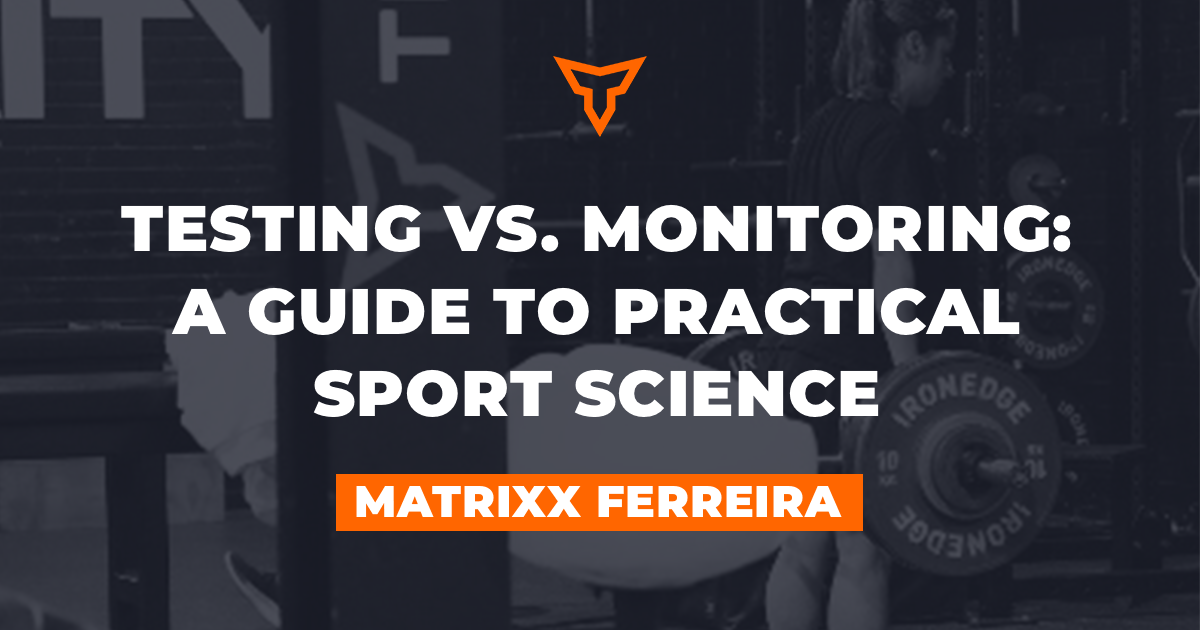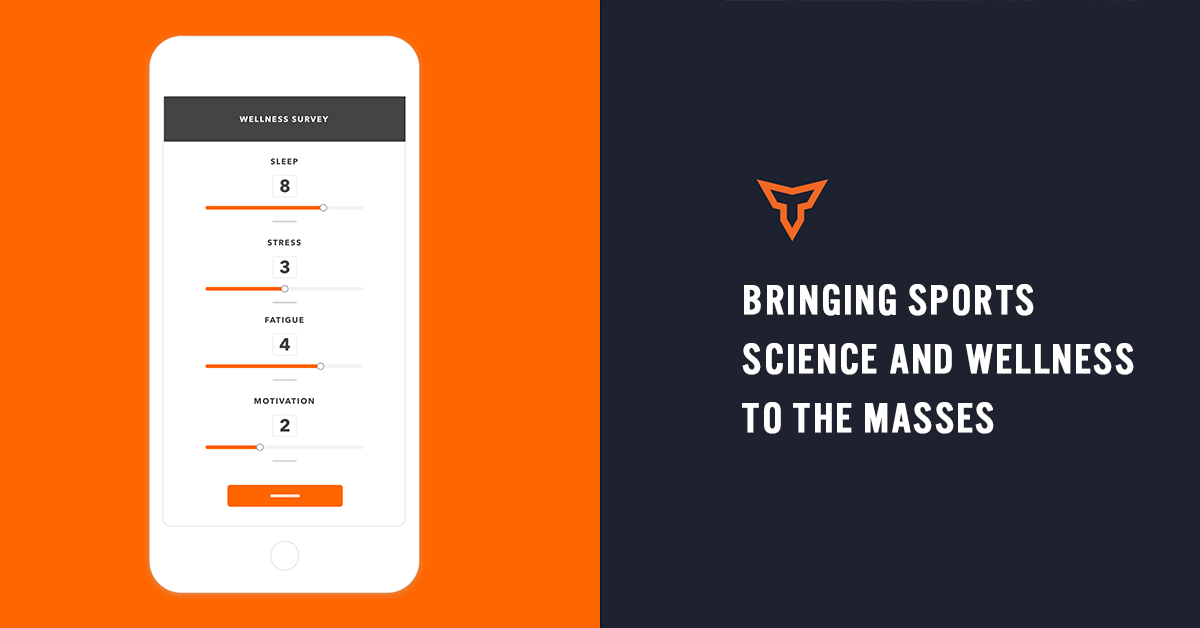Applying Sports Science At The High School Level
Every strength coach I know wants the same thing for their athletes. We all want the people we work with every day to be able to play at a higher level when they are competing. That’s it. Professional, college, and high school coaches just want their athletes to have an unfair physical advantage whenever they step into the arena and compete against someone else.
As fun as it is to post videos all over social media about the crazy things athletes can do in a training session, it doesn’t mean much if that same person is sitting at the end of the bench guarding the water coolers. If you are training to get better as an athlete, improving in the weight room has to show some improvement to the sport otherwise it is a waste of time. Within that statement, lays the ugly truth of our profession. Trying to link the improvements you see in the weight room to what is happening in the arena is difficult at best. That my friends begins the conversation about the wonderful world of sports science.
It the core of the conversation, sports science is the ability to predict performance based off of the things that we can measure outside of the competition arena. This has been happening for decades in the dark and dirty weight rooms all over the world. Coaches knew that if their teams and athletes found a way to get stronger and faster than they would be able to compete at a higher level during their competitions. The ability to measure improvement then was more or less limited to 1 rep maxes, hand held stopwatches, and tape measures. In today’s world, we have access to equipment that a decade ago was limited to what professional or Olympic athletes could afford like bar accelerometers, heart rate variability measures, force plates, and GPS units.
From professional teams to college programs, there are entire departments that have been created to interpret the data sets that all the sports science equipment is kicking out. The problem with human nature is that when we see the shiny new toy someone else has, we want to have it too. While it is sexy and your players feel good about having the same equipment as the pro’s do, far too often coaches get $0.50 of information from a $50,000 piece of equipment. So before you spend the next few years budget on a single piece of equipment, here are some considerations I would try first.
JUMPS & THROWS
The ability to generate the most amount of force as fast as you can, is probably my most important reason why you need to train. Zatsorsky and Kraemer among others have identified that in the majority of sports, people are able to generate the greatest amount of force in 0.1-0.2 seconds. This is why I say that the ability to produce power is the most important reason to train. The problem is that I don’t have any equipment that we can measure force produced in that scale of time, so I have to get creative in my testing. Lucky for us, some of the easiest tests can be done with the three pieces of equipment you already have: body weight, a medicine ball, and a tape measure.
The first test is the simple broad jump. Starting with your feet on a line, load your hips and jump. With training that jump should be getting farther and farther. Since there is minimal set up and this style of test doesn’t really stress the athletes (or coaches to interpret the data) this can be done daily. With a broad jump you can test large numbers of athletes like a football or track team relatively quickly, and the results are really easy to interpret. If you jump farther your ability to produce power has probably gotten better, if you jump shorter your ability to produce power has probably gotten worse. I say probably because body weight does play a factor in this style of test. After all there is a reason long and triple jumpers don’t look like sumo wrestlers. If you want to put in the extra work, fire up an excel document and write a formula that accounts for both the distance and body weight of the athlete. Trust me, it’s easy.
| Athlete | Body Weight | Weight Squared | Distance | Distance Squared | Power Index |
| Johnny Smith (10/1/19) | 180lbs | 32,400 | 96" | 9,216 | 204=(32,400+9216) |
| Suzy Smith (10/1/19) | 135lbs | 18,225 | 84" | 7,056 | 159 |
| Johnny Smith (11/1/19) | 182lbs | 33,124 | 95" | 9,025 | 205.3 |
| Suzy Smith (11/1/19) | 135lbs | 18,225 | 85.5" | 7,310.25 | 159.8 |
You can see in the examples above that both Johnny and Suzy’s power index shows improvement. Suzy’s scores are easy to understand because she jumped farther at the same body weight, but Johnny on the other hand can be a little confusing. How was he able to score higher while jumping a shorter distance? Well, since both of their bodies through space in order to cover as much distance as possible, you have to account for that resistance somehow on your calculations. Johnny had put on 2 pounds, and while I hope that was 2 pounds of muscle, any change of body weight does impact the distance someone can jump assuming they have the same strength and power ability.
As you can see, this can be a very powerful tool for you to use when making predictions about your athletes. While I personally like doing this with vertical and broad jumps, the same sort of equation can be used for all sorts of tests. Med ball throws, single leg jumps, and even sprints although you will need to make one slight adjustment. In the case of sprints you cannot simply use their times otherwise you would give a higher score to those who run slower. All I have done is adjust the distance score to (10 - their result) and then square that.
STRESS
It seems like whenever you turn on the TV, check the news or even your social media account there is some story about the negative effects of stress. Don’t get me wrong there is a direct link between increased stress and increased injury rates and decrease in athletic performance, especially from Dr. Mann and Dr. Seyle But does that mean that all stress needs to be avoided? Of course not. There can not be any sort of compensation from training unless you place the body and the motor units under stress. In other words: No stress, no GAINZ. The key that is often overlooked is managing stress levels.
While athletes are training, we want to see them in a state of sympathetic nervous system dominance, it’s their fight or flight stage system. This is the system that gives everyone super powers. It happens when your heart is beating so hard, so much blood and oxygen pumping through your muscles and brain, it's like rocket fuel. Right now, you can run faster, you can fight harder, and you can jump higher than ever in your life. You are very alert, it's like you can slow down time. What's wrong with that? Well, our bodies are not supposed to be in this state for a long time, because when you are in the fight or flight stage other functions of your body slows down to give your brain and muscles the energy they need. And that is a bad thing. This is where we hear about all the negative side effects of stress. So how do you know when your athletes are suffering from the negative form of stress? Well, I’m glad you asked.
Sure, you could go out and get a device that measures heart rate variability, which can see if your heart is beating because of stress hormones or not. I don’t have a budget for that and I’ve found out that by simply asking athletes some easy questions we can identify who might need to take in easy in practice or training. To those of us that are working with high school and college aged athletes, we should have a good guess when there is high academic stress, but always ask some follow-up questions to help determine the athletes relative stress levels. To make it easy as I can, the questions are kept really simple and we use a 1 to 5 scale where 1 is always the worst and 5 is the best. Here are the questions we use:
1. How well did you sleep last night?
1 (Tossed and turned all night) - 2 - 3 - 4 - 5 (Slept like a baby)
2. How are your energy levels?
1 (What energy?) - 2 - 3 - 4 - 5 (I’m in my prime!)
3. Rate your fatigue levels.
1 (Say that again, I fell asleep) - 2 - 3 - 4 - 5 (I can go for days)
4. How is pressure affecting you?
1 (Don’t push me) - 2 - 3 - 4 - 5 (Diamonds are made by heat and pressure)
5. Are you physically healthy?
1 (Falling apart) - 2 - 3 - 4 - 5 (Never better)
6. Are you ready to compete?
1 (Not even the slightest) - 2 - 3 - 4 - 5 (LFG!)
Although these are only six questions, they have not let me down in predicting how athletes are doing. Once an athlete starts trending with lower scores, we start cutting back on their lifting workloads and talk to their coaches about cutting back on their practice time. Remember, even rubber bands will break when they are stretched too far, so will athletes. If any of us are pulled too much in every direction, or even if we think we are, then we will start breaking down physically or mentally.
When I first started reading about helping athletes deal with stress and how it affects their performance, I admit that I was really hesitant. After all, I consider myself to be someone who can grind through just about any situation that I’ve been in, and these questions felt like we were giving people an excuse to be soft. Then I realized two things -- the questionnaire is like a thermometer, it is showing what degree the athletes are in. The other epiphany was that there is a difference between grinding through something and performing at your natural best.
Since we all live in a world where coaches get fired because of their win and loss records, do you want the athletes to be competing in a physically depressed state or to be at their natural best on game day? Yeah, that thought changed my mind too.
PUTTING IT TOGETHER
At the start of this article, I talked about the idea that sports science is just a tool that we all can use to predict the success of our athletes. Now at the end, I still stand by that statement. Every coach I know understands that if their team had a great year in the weight room during the off-season and everyone is bigger, stronger, and faster than they have a shot of being great the next season. The ideas that I introduced are simply ways to continue making predictions all though the year. They are quick to administer and offer a way to track people in-season and off-season. Most importantly these ideas provide useful information that is easy to understand.
You can show the most old school coach athletes’ power index numbers, and I’m willing to bet that they would understand what is happening if the scores are going up or down. I’m also willing to bet that some of you also have been using some great sports science tests in your programs. If so, let’s keep pushing the field to grow and helping each other out.
Subscribe to our blog
Subscribe to receive the latest blog posts to your inbox every week.
Related posts

How Much Does a Sport Scientist Make Anyway?

7 Things to Consider Before Building a Sport Science Program


